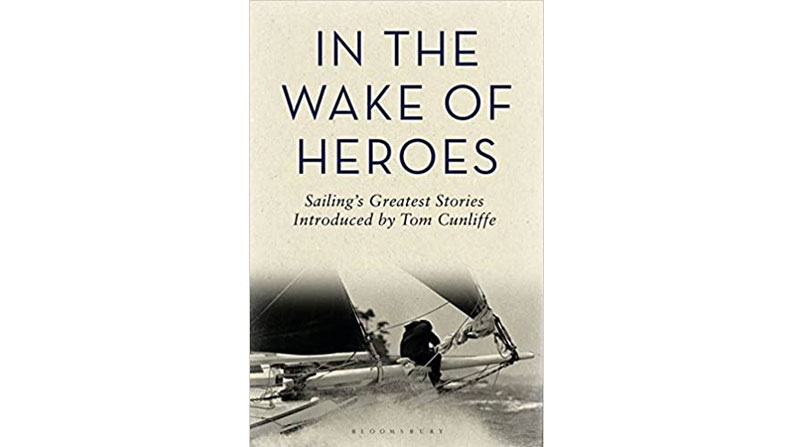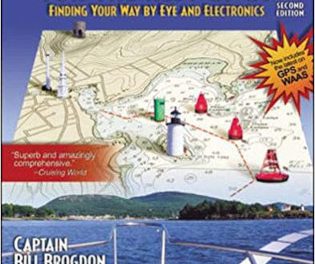 In the Wake of Heroes: Sailing’s Greatest Stories is an apt title for this collection of excerpts from sailing adventures penned over the last century and a half. Tom Cunliffe provides a brief introduction to each chapter, creating an entry point from which we are thrust into extraordinary accounts of seamanship, sport, and often unbelievable courage. The stories range the entire scope of sailing — bluewater passagemaking, high-latitude exploration, daysailing, racing — all laced together with a shared spirit of adventure and, in many cases, a sense of urgency. Readers from all walks of life will find much to appease their inner sailor.
In the Wake of Heroes: Sailing’s Greatest Stories is an apt title for this collection of excerpts from sailing adventures penned over the last century and a half. Tom Cunliffe provides a brief introduction to each chapter, creating an entry point from which we are thrust into extraordinary accounts of seamanship, sport, and often unbelievable courage. The stories range the entire scope of sailing — bluewater passagemaking, high-latitude exploration, daysailing, racing — all laced together with a shared spirit of adventure and, in many cases, a sense of urgency. Readers from all walks of life will find much to appease their inner sailor.
Tom opens by explaining the book’s origins: a proposal by Andrew Bray in 2004, the then-editor of Yachting Magazine, for a series of articles that Cunliffe would produce culled from a wide-range of maritime literature. The focus would concentrate on “exceptional feats of seamanship.” Cunliffe delivered, and the Great Seamanship column was founded. Its popularity among subscribers was unprecedented and ultimately became the prime resource for this volume. Cunliffe tells us that these were “the books that sent me to sea back in the 1960s”— authors like James Wharram, Alvah Simon, Edward Allcard, and Uffa Fox. But besides the maritime legends, Cunliffe incorporates a host of unlikely and, in some cases, downright obscure authors who diligently penned their adventures in letters, ships’ logs, magazines, and club journals.
From the more famous bunch, none other than Rockwell Kent, our great American Social Realist artist and poet, describes a night navigating a crew through heavy fog off the coast of Greenland, at times sailing so close to an invisible lee shore as to be surrounded on three sides by rocks. Kent’s “admirable work in the navigation department” saves the day, dependent entirely upon dead-reckoning to pick his way out of treacherous situations, long before the invention of GPS.
Desperate Driving has the author, Erling Tambs, sailing a sinking ship with his wife, infant son, and beloved dog, Spare Provisions, aboard. The seams have opened on their Colin Archer cutter just outside the pass leaving Tahiti. No amount of bailing will remedy the influx, so the only option is to throw caution to the trades and fly full sail in an effort to reach Moorea. It is an epic race against time that takes place over the course of just a few short hours, but the seamanship and courage is marvelous and ultimately wins the day.
In the excerpts by HW Tillman and Alvah Simon, both writers describe high latitude sailing adventures and close encounters with ice. Edward Allcard, in Temptress Returns, finds a beautiful stowaway onboard who makes his acquaintance 24 hours after leaving the Azores as a result of her desperate quest to start a new life in England. The multihull pioneer James Wharram tells of crossing an ocean on a homemade catamaran with an all female crew (one per hull), while Val Howell’s inclusion from his book, Sailing into Solitude, is half spun by an imaginary specter that has come to loathe Howell’s very presence onboard. And what collection of seafaring tales is complete without an entry from Uffa Fox, who describes sailing through a harrowing November blow with a “sheer delight in living” that could only come from someone with intelligence born of the sea?
From less notorious origins, the Log of the Portsmouth Sea Scouts from 1948 reveals a true account about a handful of boys who are given the assignment of rowing/sailing an open, lug-rigged ex-naval cutter on an unsupervised overnight voyage up the Solent. Cunliffe himself asks, “Can you imagine youngsters being allowed to do that sort of thing today?”
Equally compelling from the category of less-famous authors is an excerpt from Sailing to Freedom, a splendid story by Voldemar Veedam and Carl B. Wall about a group of Estonian refugees fleeing the horrors of the Nazi regime in a 37-foot semi-derelict ex-working boat. Sixteen men, women, and children sneak away from the coast at night only to face the treacherous North Atlantic in late October. Slammed by a gale 500 miles off the coast of Cape Hatteras — ever so close to freedom — they find themselves fighting for survival. Amazingly, the heroine is an elderly grandmother who saves the ship by suggesting the employment of a drogue to keep them from turning broadside in the 40-foot seas. It works.
The stories are satisfying and the resources listed provide a trail of breadcrumbs for us to follow for building a fine maritime library of our own.
In the Wake of Heroes: Sailing’s Greatest Stories by Tom Cunliffe (Adlar Coles, 2015, 272 pages)





